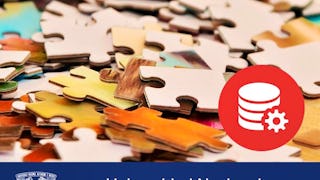Démarrez avec les bases de données NoSQL avec ce cours d'introduction convivial pour les débutants ! Ce cours vous apportera des connaissances techniques et pratiques sur les bases de données NoSQL et les offres de Base de données en tant que service (DaaS). Avec l'avènement du Big Data et des méthodologies de développement agile, les bases de données NoSQL ont gagné beaucoup de pertinence dans le paysage des bases de données. Leur principal avantage est la capacité à gérer les problèmes d'évolutivité et de flexibilité que soulèvent les applications modernes.

Profitez d'une croissance illimitée avec un an de Coursera Plus pour 199 $ (régulièrement 399 $). Économisez maintenant.

Introduction aux bases de données NoSQL
Ce cours fait partie de plusieurs programmes.



Instructeurs : Rav Ahuja
56 692 déjà inscrits
Inclus avec
(367 avis)
Expérience recommandée
Ce que vous apprendrez
Faites la différence entre les quatre catégories principales de référentiels NoSQL.
Décrivez les caractéristiques, les avantages, les limites et les applications des outils de traitement des Big Data les plus populaires.
Effectuer des tâches courantes à l'aide de MongoDB, notamment des opérations de création, de lecture, de mise à jour et de suppression (CRUD).
Exécutez des opérations sur les espaces clés, les tables et les opérations CRUD dans Cassandra.
Compétences que vous acquerrez
- Catégorie : Évolutivité
- Catégorie : IBM Cloud
- Catégorie : Apache Cassandra
- Catégorie : Modélisation des données
- Catégorie : Informatique distribuée
- Catégorie : Gestion des bases de données
- Catégorie : Architecture et administration des bases de données
- Catégorie : Langage de requête
- Catégorie : NoSQL
- Catégorie : Bases de données
- Catégorie : MongoDB
- Catégorie : Manipulation de données
- Catégorie : JSON
Détails à connaître

Ajouter à votre profil LinkedIn
15 devoirs
Découvrez comment les employés des entreprises prestigieuses maîtrisent des compétences recherchées

Élaborez votre expertise du sujet
- Apprenez de nouveaux concepts auprès d'experts du secteur
- Acquérez une compréhension de base d'un sujet ou d'un outil
- Développez des compétences professionnelles avec des projets pratiques
- Obtenez un certificat professionnel partageable

Il y a 5 modules dans ce cours
NoSQL signifie "Pas seulement SQL". Le terme désigne une classe de bases de données dont l'architecture n'est pas relationnelle. Les bases de données NoSQL ont leurs racines dans la communauté open-source et sont devenues plus populaires en raison des exigences du Big Data. Dans ce module, vous découvrirez les caractéristiques des NoSQL et les quatre principales catégories de bases de données NoSQL : document, clé-valeur, colonne et graphe. Vous explorerez les différences entre les modèles de cohérence ACID et BASE, les avantages et les défis des systèmes distribués, ainsi que le théorème CAP et ses caractéristiques. Vous apprendrez également à décider quand utiliser les SGBDR et quand utiliser les NoSQL.
Inclus
11 vidéos2 lectures4 devoirs9 plugins
MongoDB est une base de données NoSQL orientée documents. Les bases de données MongoDB sont faciles d'accès grâce à l'indexation. Ces bases de données prennent en charge différents types de données, y compris les dates et les nombres. MongoDB est la base de données NoSQL la plus populaire à l'heure actuelle. Elle permet aux utilisateurs d'interroger, de manipuler et de trouver des informations intéressantes à partir des données collectées. Elle peut également être utilisée à des fins diverses en raison de sa souplesse de stockage de données structurées ou non structurées. Dans ce module, vous découvrirez les caractéristiques de MongoDB et développerez vos connaissances pratiques de MongoDB en effectuant diverses tâches courantes, y compris les opérations de création, de lecture, de mise à jour et de suppression (CRUD), la limitation et le tri des enregistrements, l'indexation et l'agrégation. Vous explorerez la réplication et le sharding, qui sont des capacités qui soutiennent l'évolutivité et la disponibilité observées avec MongoDB.
Inclus
8 vidéos2 lectures4 devoirs5 éléments d'application4 plugins
Apache Cassandra est une base de données open source qui est utilisée de préférence par les applications "toujours disponibles". Ces applications ont besoin d'une base de données toujours disponible (hautement disponible) et qui évolue rapidement dans des situations de trafic élevé sans compromettre les performances. Apache Cassandra est idéal pour les services en ligne tels que Netflix, Uber et Spotify. Dans ce module, vous découvrirez les caractéristiques d'Apache Cassandra. Vous développerez également vos connaissances pratiques sur l'exécution des tâches courantes de Cassandra, y compris l'utilisation de l'interpréteur de commandes CQL, les opérations sur les espaces clés, les opérations sur les tables et les opérations CRUD.
Inclus
10 vidéos2 lectures4 devoirs4 éléments d'application4 plugins
Ce module contient le projet final de ce cours. Vous consoliderez les compétences acquises tout au long de ce cours en les appliquant à un scénario spécifique. Pour mener à bien ce projet, vous devez démontrer que vous possédez les compétences nécessaires pour effectuer les tâches décrites. Vos pairs noteront ce projet final.
Inclus
2 lectures1 devoir1 évaluation par les pairs2 éléments d'application2 plugins
La Base de données en tant que service (DBaaS) est une solution populaire pour les applications hybrides multi-cloud. IBM Cloudant est une DBaaS entièrement gérée, construite sur le logiciel open source Apache CouchDB. Cloudant a pour objectif d'être la couche de données pour toutes vos applications web et mobiles. Dans ce module, vous découvrirez à quel point le développement d'applications web modernes est simple grâce aux riches fonctionnalités de Cloudant et à son magasin de documents JSON.Vous explorerez l'architecture de Cloudant en tant que base de données NoSQL. Vous découvrirez l'architecture de Cloudant en tant que base de données NoSQL. Vous acquerrez une expérience pratique des capacités et des technologies clés de Cloudant. Vous apprendrez également à utiliser le tableau de bord de Cloudant pour créer et gérer votre base de données.
Inclus
8 vidéos3 lectures2 devoirs3 éléments d'application6 plugins
Obtenez un certificat professionnel
Ajoutez ce titre à votre profil LinkedIn, à votre curriculum vitae ou à votre CV. Partagez-le sur les médias sociaux et dans votre évaluation des performances.
Instructeurs


Offert par
En savoir plus sur Gestion des données
 Statut : Essai gratuit
Statut : Essai gratuitBoard Infinity
 Statut : Essai gratuit
Statut : Essai gratuit Statut : Essai gratuit
Statut : Essai gratuitUniversidad Nacional Autónoma de México
 Statut : Essai gratuit
Statut : Essai gratuit
Pour quelles raisons les étudiants sur Coursera nous choisissent-ils pour leur carrière ?




Avis des étudiants
367 avis
- 5 stars
73,84 %
- 4 stars
18,25 %
- 3 stars
3,81 %
- 2 stars
1,63 %
- 1 star
2,45 %
Affichage de 3 sur 367
Révisé le 26 nov. 2023
I thoroughly enjoyed learning about NOSQL Databases.
Révisé le 4 oct. 2021
Useful lab for skimming through different databases. The session of Cloudant, however, looks more like a sales material... This course is overall very good!
Révisé le 3 nov. 2023
Great introductory course for main NoSQL databases. Great material and practical assignments
Foire Aux Questions
Pour accéder aux supports de cours, aux devoirs et pour obtenir un certificat, vous devez acheter l'expérience de certificat lorsque vous vous inscrivez à un cours. Vous pouvez essayer un essai gratuit ou demander une aide financière. Le cours peut proposer l'option "Cours complet, pas de certificat". Cette option vous permet de consulter tous les supports de cours, de soumettre les évaluations requises et d'obtenir une note finale. Cela signifie également que vous ne pourrez pas acheter un certificat d'expérience.
Lorsque vous vous inscrivez au cours, vous avez accès à tous les cours du certificat et vous obtenez un certificat lorsque vous terminez le travail. Votre certificat électronique sera ajouté à votre page Réalisations - à partir de là, vous pouvez imprimer votre certificat ou l'ajouter à votre profil LinkedIn.
Plus de questions
Aide financière disponible,






